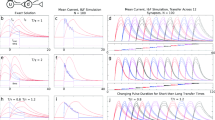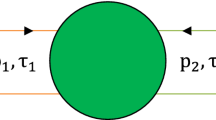Summary
-
1.
Linkages of multiple distinct event generators, coupled so that the firing of any one triggers the remainder, are found in many biological settings. This paper analyzes such networks under the assumption that individual event generators emit discrete events of a fixed type in a more-orless random time series. The aspects of their behavior studied herein include the frequency of network event emissions, their regularity, and their sensitivity to stimuli impinging equally on all generators. This analysis includes rhythm-generating and information-encoding functions within its purview.
-
2.
Under specified conditions on the “ageing” properties of interevent intervals characterizing individual generators, the output frequency of such networks depends weakly on the number of more-or-less similar generators in the network. This phenomenon, termedpseudosaturation, would promote robustness of function in the face of injury or elaborational error, and is enhanced when all generators exhibit a substantial sure silent period following event emission.
-
3.
Given certain assumptions about the manner of encoding and decoding of a single stimulus parameter, networks whose function is to encode information improve their overall signal-to-noise ratios with increasing numbers of generators. Where the properties of the generators permit pseudosaturation in output rate, this improvement comes about at a low expense of dynamic range, so that in addition to redundancy, this type of linkage offers a potentially adaptive means of channel compression.
-
4.
The dependence of generator output on an encoded stimulus parameter may be severely distorted under mutually-triggering linkage. Conditions guaranteeing the absence of various degrees of distortion are given, and the possible selective advantage of serious distortion in respect of reducing sensitivity to extraneous influences is discussed.
-
5.
The mutually-triggering feature in networks functioning to produce rhythmic behavior does not necessarily enhance the regularity of a rhythm, the presence of enhancement depending both upon the detailed statistical characteristics of the constituent generators, and upon the statistic used to assess “regularity”. Larger networks generally display less variation in longterm output frequency, but their instantaneous frequencies seem to be more constant only when individual generators tend to emit a substantial number of atypically long intervals, and/or exhibit sizeable post-event silent periods.
-
6.
Various of the ideas developed are applied to two systems which have been studied experimentally. Mutual triggering between different spikeinitiating zones in the lateral-line afferents ofXenopus laevis can not at present be shown to improve signal-to-noise ratio, sensitivity, or robustness — its function remains unknown. The published statistical properties of isolated marginal-ganglion oscillators in scyphomedusae would permit, in the absence of influences other than mutual triggering, both increases in robustness and in rhythm regularity. Experiments are suggested to determine the nature of additional influences known to exist.
Similar content being viewed by others
References
Bullock, T. H., Horridge, G. A.: Structure and function in the nervous systems of invertebrates. Ch. III, Vol I, pp. 502–506. San Francisco: W. H. Freeman and Company 1965
Calabrese, R. L., Kennedy, D.: Multiple sites of spike initiation in a single dendritic system. Brain Res.82, 316–321 (1974)
Cox, D. R.: Renewal theory. London: Methuen and Company, Ltd. 1962
Cox, D. R., Miller, H. D.: The theory of stochastic processes. New York: John Wiley and Sons Inc. 1965
David, H. A.: Order statistics. New York: John Wiley and Sons Inc. 1970
Griffith, J. S.: Mathematical neurobiology. New York: Academic Press 1971
Gumbel, E. J.: The statistics of extremes. New York: Columbia University Press 1958
Harris, G. G., Flock, Å.: Spontaneous and evoked activity from theXenopus laevis lateral-line. In: Lateral line detectors (P. Cahn, ed.), pp. 163–197. Bloomington: Indiana University Press 1967
Harris, G. G., Milne, D. C.: Input-output characteristics of the lateral-line sense organ. J. acoust. Soc. Amer.40, 32–42 (1966)
Horridge, G. A.: The nerves and muscles of medusae. VI. The rhythm. J. exp. Biol.36, 72–89 (1959)
Kennedy, D., Mellon, D. F.: Receptive-field organization and response patterns in neurons with spatially-distributed input. In: Neural theory and modelling (ed. R. F. Reiss), pp. 400–413. Stanford: Stanford University Press 1964
Korn, H., Bennett, M. V. L.: Dendritic and somatic impulse initiation in fish oculomotor neurons during vestibular nystagmus. Brain Res.27, 169–175 (1971)
Lerner, J., Mellen, S. A., Waldron, I., Factor, R. M.: Neural redundancy and regularity of swimming beats in Scyphozoan medusae. J. exp. Biol.55, 177–184 (1971)
Lindblom, U., Tapper, D. N.: Integration of impulse activity in a peripheral sensory unit. Exp. Neurol.15, 63–69 (1966)
McFarlane, I. D.: Spontaneous contractions and nerve net activity in the sea anemoneCalliactis parasitica. Mar. Behav. Physiol.2, 97–113 (1973)
McFarlane, I. D.: Control of the pacemaker system of the nerve-net in the sea anemoneCalliactis parasitica. J. exp. Biol.61, 129–143 (1974)
Murray, M. J.: Impulse occlusion and subthreshold gating in electrically coupled molluscan neurons. J. comp. Physiol.103, 189–208 (1975)
Murray, M. J., Capranica, R. R.: Spike generation in the lateral-line afferents ofXenopus laevis: evidence favoring multiple sites of initiation. J. comp. Physiol.87, 1–20 (1973)
Murray, R. W.: The lateral-line organs and their innervation inXenopus laevis. Quart. J. micr. Sci.96, 351–361 (1965)
Nicholls, J. G., Baylor, D. A.: Specific modalities and receptive fields of sensory neurons in the CNS of the Leech. J. Neurophysiol.31, 740–756 (1968)
O'Shea, M.: Two sites of axonal spike-initiation in a bimodal interneuron. Brain Res.96, 93–98 (1975)
Pabst, H., Kennedy, D.: Cutaneous mechanoreceptors influencing motor output in the crayfish abdomen. Z. vergl. Physiol.57, 190–208 (1967)
Pantin, C. F. A., ViannaDias, M.: Rhythm and afterdischarge in medusae. Ann. Acad. Bras. Sci.24, 351–364 (1952)
Parzen, E.: Stochastic processes. San Francisco: Holden-Day, Inc. 1962
Passano, L. M.: Pacemakers and activity patterns in medusae: homage to Romanes. Amer. Zool.5, 465–481 (1965)
Pavlidis, T.: Biological oscillators: Their mathematical analysis. New York: Academic Press 1973
Perkel, D. H., Bullock, T. H.: Neural coding. In: Neuroscience Research Symposium Summaries, Vol. III (eds. F. O. Schmitt, T. Melnechuk, G. C. Quarton, G. Adelman). Cambridge: MIT Press 1969
Perkel, D. H., Gerstein, G. L., Moore, G. P.: Neuronal spike trains and stochastic point processes. I. The single spike train. Biophys. J.7, 391–418 (1967)
Rodieck, R. W., Kiang, N. Y. S., Gerstein, G. L.: Some quantitative methods for the study of spontaneous activity of single neurons. Biophys. J.2, 351–368 (1962)
Rosenblith, W. A.: Processing neuroelectric data. Cambridge: MIT Press 1962
Russell, I. J.: The role of the lateral-line efferent system inXenopus laevis. J. exp. Biol.54, 621–641 (1971)
Sand, O., Ozawa, S., Hagiwara, S.: Electrical and mechanical stimulation of hair cells in the mudpuppy. J. comp. Physiol.102, 13–26 (1975)
Siebert, W. M.: Some implications of the stochastic behavior of primary auditory neurons. Kybernetik2, 206–125 (1965)
Author information
Authors and Affiliations
Additional information
This research was supported by the National Science Foundation (Engineering Research Initiation Grant GK-42107). The work benefited from discussions with A. Gelperin, P.S.G. Stein, and T. H. Bullock. D. Lawler and D.Barry did the computer programming and inputting/outputting: the numerical computations presented (except on the jellyfish data) herein are due to Barry's labor. I also profited from strictly mathematical talk over beer with K. Steiglitz and A.C. Murray. C. van den Honnert did the experimental work to obtain the firing-frequency data for lateral-line fibers.
Rights and permissions
About this article
Cite this article
Murray, M.J. Systems of mutually-triggering event generators: Basic properties and functions in information transmission and rhythm generation. J. Comp. Physiol. 117, 63–98 (1977). https://doi.org/10.1007/BF00605524
Received:
Issue Date:
DOI: https://doi.org/10.1007/BF00605524




